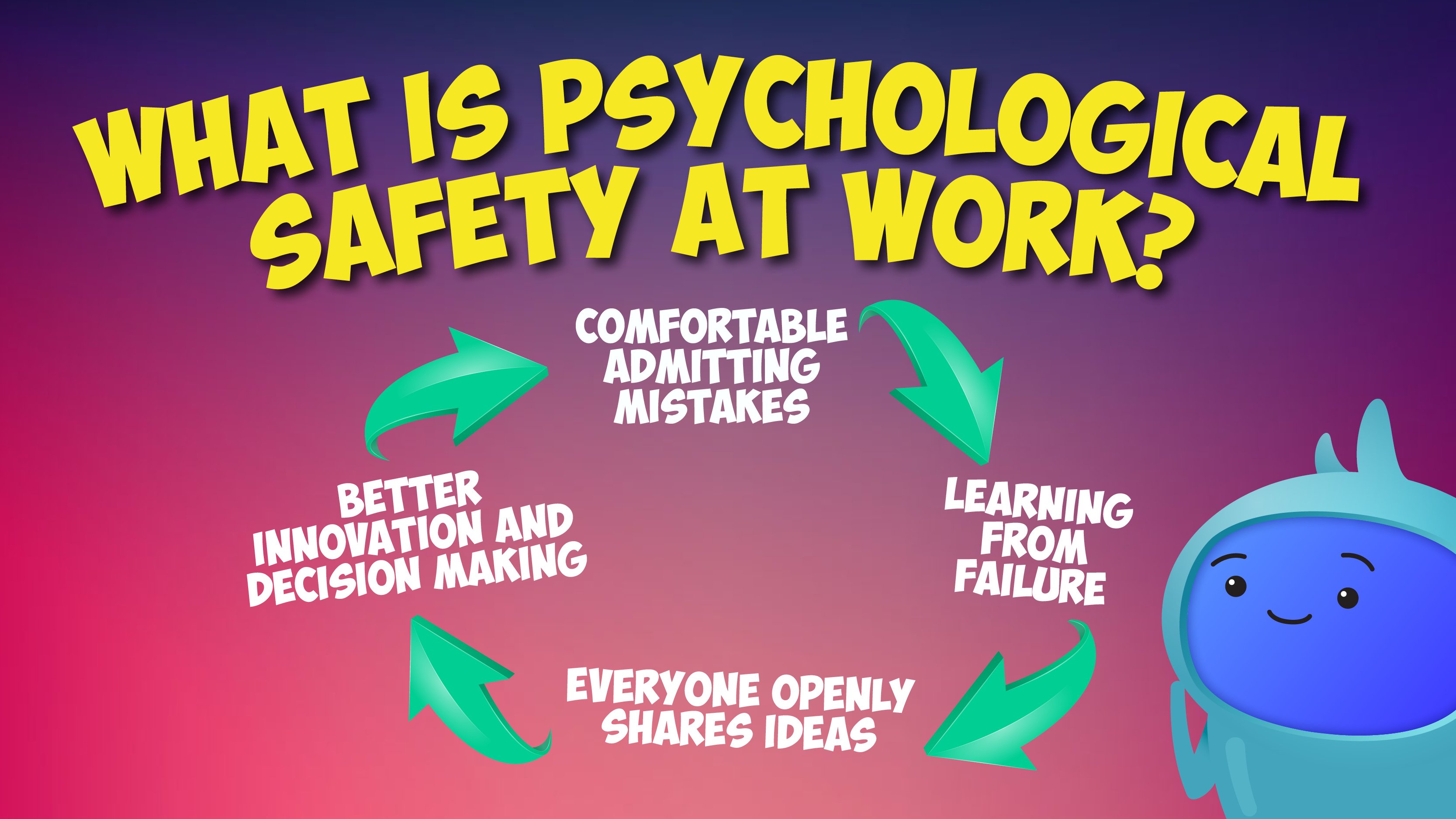We did consider sharing our own perspective on psychological safety, but as a quick Google will tell you, there’s a wealth of information out there already. So, instead of reinventing the wheel, we’ve collected what we consider to be the most powerful, significant and inspiring of the bunch, adding why we rate them so highly. Of course, there are plenty of additional thoughts and resources out there, but these made us sit up, take note and pay attention.
‘A sense of inclusion, safety to learn, safety to contribute and safety to challenge.’ Dr. Timothy Clark
‘The belief that one can speak up without risk of punishment or humiliation has been well established as a critical driver of high quality decision making… greater innovation and more effective execution in organisations.’ Amy Edmondson
Why care about psychological safety in the workplace?
So why should psychological safety be something that you seek to include in your workplace? Well, for a multitude of reasons, being aware of the kind of environment that you create and how it makes a team feel can both directly and indirectly impact how successful the business is.
It might sound overly dramatic, but increasingly as job seekers consider a workplace, and especially in a post pandemic world, wellbeing, collaboration and a sense of belonging are ranking high up on the list of what they’re looking for. In fact, this has a great impact on a business output and there are studies that show that a sense of belonging can improve productivity by as much as 50%.
It can also help to lower churn within your team. The 2021 People Management Report shows that of those who self-determined they had “bad managers”, 63% of respondents would be looking to move roles in the next 12 months. That loss of knowledge, interruption to workflows and costs of replacing and upskilling new workers can be devastating to small and new businesses.
There are numerous other stories and studies that have been conducted around why psychological safety is central to success. The team at Betterup have brought together a host of sources and resources you can read here: Why psychological safety at work matters
Working out what it actually means for your business
There’s a hell of a lot of psychological safety information out there. And just when you think you’ve got the scope of it in your head, you learn that what feels safe, comfortable and healthy to someone, is actually in flux. What we want from work, from our colleagues and shared spaces, changes over time. This means your task is not only understanding how people currently experience PS and creating room for it, but also embedding ways to temperature check and iterate.
For an initial psychological safety audit (getting an idea of the reality) and when prompted by big changes (think high turnover, new team, business shift, office move etc.), we love these two approaches: Amy Edmondson’s psychological safety map and Miro’s team psychological safety workflow.
Let’s start with the creative one pager (designed by Amelia Crabtree). This could be inspired from many starting points - perhaps your company or team values. Maybe it’s populated by engagement survey results, HR issues, a leadership team exercise. It can help to isolate the key things people want from the culture, or the core issues they face. Aspirational or current. Anonymous or focus group.
You can map this over time - do the same things come up? Something new which needs attention? Does it look different across levels or areas of the business? Get ready to spot trends, priorities and ideas.

If you’re looking to take a deeper dive or for something more interactive, check out Miro’s template for team psychological safety. If you have a Miro account, you can customise it or add it to an existing board. You can also just zoom in and be inspired by the suggested group activities - from rating the current state of safety using red dots and emojis to brainstorming and action planning sessions.
Making room, not just lifting up
Timothy R. Clark’s feature in Harvard Business Review, ‘How a CEO can create Psychological Safety in the Room,’ is worth a thorough read and relevant beyond the CEO pool. It’s an in-depth reminder of the power of authority and influence on others.
We want to draw specific attention to number 8 of his 10 practical tips, ‘Buffer Strong Personalities,’ because it’s easy to focus exclusively on creating a culture where everyone can speak up, and forget that sometimes you need to make room too.
A talking stick is probably taking it too far, but there are lots of subtle, non-aggressive moves we can make so it’s not always the same few people in the spotlight. Giving people time to think in advance if they’re more reflective, asking for thoughts in advance and exploring them later with the group and directing questions to individuals you want to hear more from are just a few ideas.
When typically more reserved people do share, try to reinforce this as a positive experience. Tim suggests going beyond thanking someone for what they say, to explaining why you found it so valuable. I’m sure we’ve heard many a panel member say, ‘Thank you, that’s a really good question,’ and just assume they’re buying thinking time. Why was that contribution so prized? As the old adage goes, reward what you want repeated.
It's not soft and fluffy
We’re coming back to Amy for this one (and rightly so, she put psychological safety on the agenda). In this conversation with David Green, Amy addresses some easy misconceptions about the…well, the concept. Including the incorrect belief that it’s about everyone being gentle and in peaceful agreement: ‘It’s not being nice or soft, or guaranteed applause for everything you have to say….it’s a very energising but candid place.’
She goes on to stress the importance of inviting input and challenge, not just expecting that people will feel comfortable to be honest and direct (especially if that kind of talk has historically been discouraged). Psychological safety is not easily achieved and sustained - it takes a lot of proactivity and consideration.
Most people will need to see it to believe it; leaders admitting they got something wrong or aren’t sure, managers welcoming critique or people pointing out their blind spots. It’s a lived state not a one-off tick box. If you really want to encourage a range of voices in your organisation which can respectfully question and disagree, you’ll potentially have to hear things you don’t like or believe…and respond with grace and curiosity.
Think beyond short-termism
It might be tempting to reach for quick wins and roll out a few nice-to-have initiatives, then pat yourself on the back. As this LinkedIn post from Fika co-founder Nick Bennett laments, if we don’t follow the symptoms to the root, we risk not impacting it at all. He asks, ‘Are we throwing a confusing array of wellbeing offers at the problem?’
He urges business owners to focus on preventing and addressing bad behaviours and practices, rather than painting over them. It’s worth checking out his practical ideas on how to move towards this (and away from fun activities as the only strategy).
Nick also references Sarah O’Connor’s Financial Times feature, ‘What if work is making us sick?’, which presents data to support the claim that, ‘work has become easier on our bodies but tougher on our minds.’
A continuous lack of psychological safety at work or being stuck in fight, flight or freeze can have very serious consequences on our health. It’s a vital part of the wellbeing conversation (though not the only contributor), and we all want to and deserve to, work somewhere which prioritises our health, not damages it.

Financial Times: Why if work is making us sick?
Where can you get some more practical hands-on stuff?
So it will come as a surprise to nobody who knows us, that we love a good book. They can be handy to provide insight, learning and perspective on just about any topic - and psychological safety is no exception. We’d like to share some suggestions of where might be a good place to start if you’d like some more information. This is in no means an exhaustive list, and if you have any books you’d like to suggest - book recommendations are always welcome in our inbox.
The Fearless Organization by Amy Edmondson
A great place to start may well be Amy Edmondson’s book, The Fearless Organization. Amy coined the term psychological safety and we know she’s popped up a few times in our blog, so it would feel rude to not include her book here as a great place to get further insight.
There is also a podcast that goes along with the publication where you can hear her talking about the book and ideas in more depth here.
Radical Candor by Kim Scott
Next up is Radical Candor - an interesting way to provide clear and honest conversations to create and transform relationships in the workplace. This book provides both an interesting discussion on the philosophy side of speaking candidly as well as provide tools and techniques for weaving the ideas into everyday conversations in the workplace.
The Culture Map by Erin Meyer
The Culture Map provides a great reference for those that work with colleagues across different continents. As there is no one size fits all for what might make someone feel psychological safety at work, so this book helps to understand that different cultures feed into those expectations from very different angles.
A Dutiful Boy by Mohsin Zaidi
Last up is a non fiction memoir of Mohsin Zaidi, called A Dutiful Boy. It provides a real world example of why having a psychologically safe space is important in helping people to realise their potential.
Want to learn more about psychological safety?
If you're looking to make your workplace a happier and more productive place to be, take a look at our Psychological Safety learning collection, with everything you need to get started!



.png)
